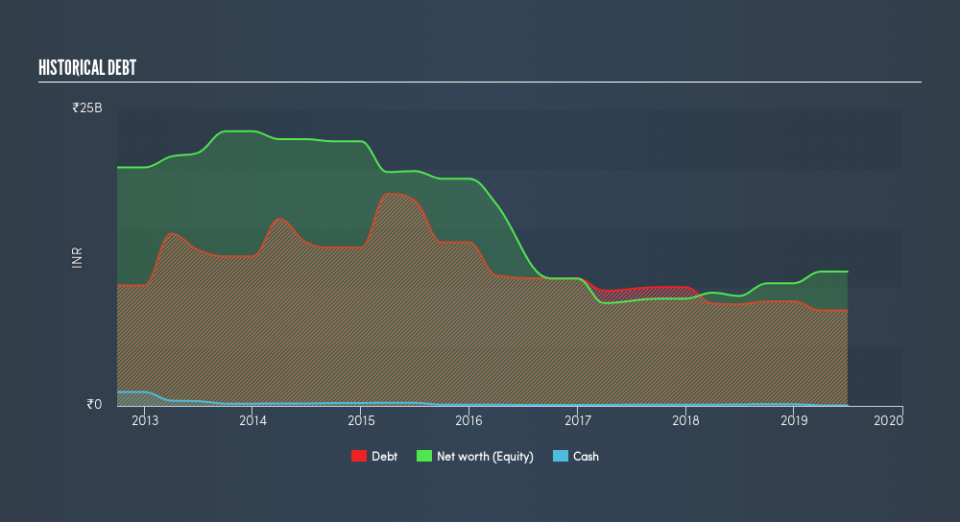Here's Why Opto Circuits (India) (NSE:OPTOCIRCUI) Has A Meaningful Debt Burden

The external fund manager backed by Berkshire Hathaway's Charlie Munger, Li Lu, makes no bones about it when he says 'The biggest investment risk is not the volatility of prices, but whether you will suffer a permanent loss of capital.' So it seems the smart money knows that debt - which is usually involved in bankruptcies - is a very important factor, when you assess how risky a company is. We note that Opto Circuits (India) Limited (NSE:OPTOCIRCUI) does have debt on its balance sheet. But the more important question is: how much risk is that debt creating?
When Is Debt A Problem?
Generally speaking, debt only becomes a real problem when a company can't easily pay it off, either by raising capital or with its own cash flow. In the worst case scenario, a company can go bankrupt if it cannot pay its creditors. While that is not too common, we often do see indebted companies permanently diluting shareholders because lenders force them to raise capital at a distressed price. Of course, plenty of companies use debt to fund growth, without any negative consequences. When we think about a company's use of debt, we first look at cash and debt together.
See our latest analysis for Opto Circuits (India)
How Much Debt Does Opto Circuits (India) Carry?
The image below, which you can click on for greater detail, shows that Opto Circuits (India) had debt of ₹8.03b at the end of March 2019, a reduction from ₹8.58b over a year. Net debt is about the same, since the it doesn't have much cash.
How Strong Is Opto Circuits (India)'s Balance Sheet?
The latest balance sheet data shows that Opto Circuits (India) had liabilities of ₹8.30b due within a year, and liabilities of ₹1.39b falling due after that. On the other hand, it had cash of ₹44.1m and ₹886.1m worth of receivables due within a year. So its liabilities outweigh the sum of its cash and (near-term) receivables by ₹8.76b.
This deficit casts a shadow over the ₹1.20b company, like a colossus towering over mere mortals. So we definitely think shareholders need to watch this one closely. At the end of the day, Opto Circuits (India) would probably need a major re-capitalization if its creditors were to demand repayment.
In order to size up a company's debt relative to its earnings, we calculate its net debt divided by its earnings before interest, tax, depreciation, and amortization (EBITDA) and its earnings before interest and tax (EBIT) divided by its interest expense (its interest cover). The advantage of this approach is that we take into account both the absolute quantum of debt (with net debt to EBITDA) and the actual interest expenses associated with that debt (with its interest cover ratio).
As it happens Opto Circuits (India) has a fairly concerning net debt to EBITDA ratio of 12.9 but very strong interest coverage of 23.5. This means that unless the company has access to very cheap debt, that interest expense will likely grow in the future. Notably Opto Circuits (India)'s EBIT was pretty flat over the last year. We would prefer to see some earnings growth, because that always helps diminish debt. There's no doubt that we learn most about debt from the balance sheet. But you can't view debt in total isolation; since Opto Circuits (India) will need earnings to service that debt. So when considering debt, it's definitely worth looking at the earnings trend. Click here for an interactive snapshot.
Finally, while the tax-man may adore accounting profits, lenders only accept cold hard cash. So the logical step is to look at the proportion of that EBIT that is matched by actual free cash flow. During the last three years, Opto Circuits (India) produced sturdy free cash flow equating to 71% of its EBIT, about what we'd expect. This free cash flow puts the company in a good position to pay down debt, when appropriate.
Our View
Opto Circuits (India)'s level of total liabilities and net debt to EBITDA definitely weigh on it, in our esteem. But its interest cover tells a very different story, and suggests some resilience. We should also note that Medical Equipment industry companies like Opto Circuits (India) commonly do use debt without problems. When we consider all the factors discussed, it seems to us that Opto Circuits (India) is taking some risks with its use of debt. So while that leverage does boost returns on equity, we wouldn't really want to see it increase from here. Given our hesitation about the stock, it would be good to know if Opto Circuits (India) insiders have sold any shares recently. You click here to find out if insiders have sold recently.
Of course, if you're the type of investor who prefers buying stocks without the burden of debt, then don't hesitate to discover our exclusive list of net cash growth stocks, today.
We aim to bring you long-term focused research analysis driven by fundamental data. Note that our analysis may not factor in the latest price-sensitive company announcements or qualitative material.
If you spot an error that warrants correction, please contact the editor at editorial-team@simplywallst.com. This article by Simply Wall St is general in nature. It does not constitute a recommendation to buy or sell any stock, and does not take account of your objectives, or your financial situation. Simply Wall St has no position in the stocks mentioned. Thank you for reading.

